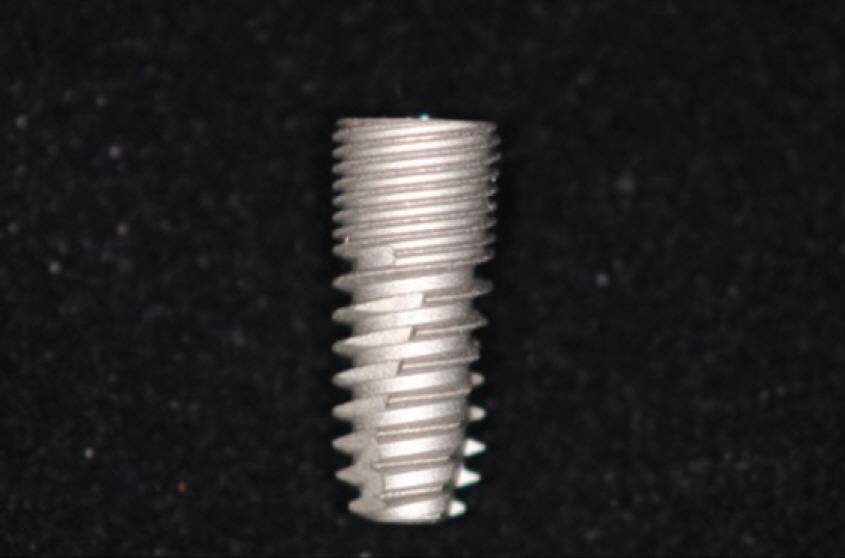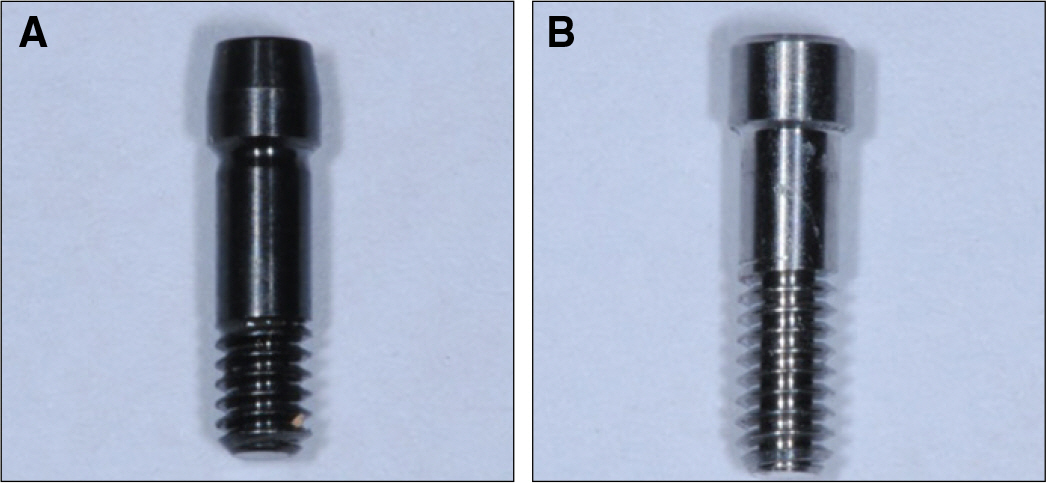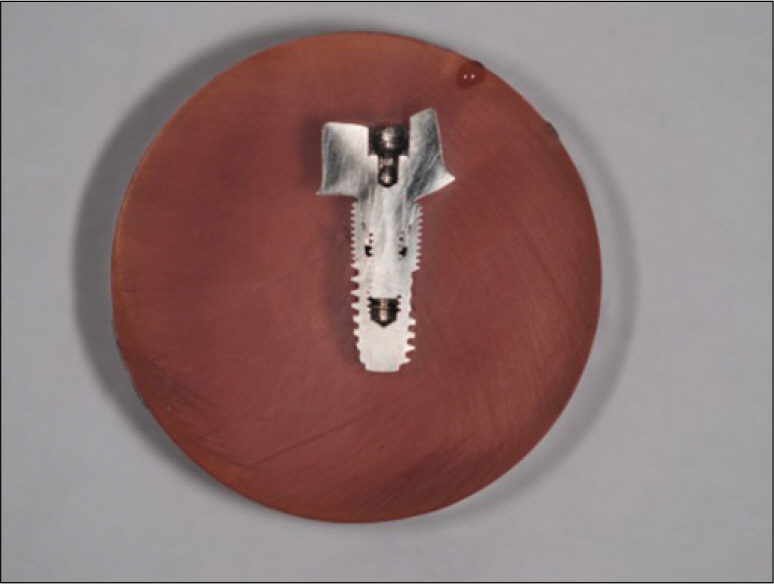J Korean Acad Prosthodont.
2013 Oct;51(4):276-283. 10.4047/jkap.2013.51.4.276.
A comparative study on the fit and screw joint stability of ready-made abutment and CAD-CAM custom-made abutment
- Affiliations
-
- 1Department of Prosthodontics, School of Dentistry, Chosun University, Gwangju, Republic of Korea. jhajung@chosun.ac.kr
- KMID: 2000151
- DOI: http://doi.org/10.4047/jkap.2013.51.4.276
Abstract
- PURPOSE
The purpose of this study was to investigate the fit and screw joint stability between Ready-made abutment and CAD-CAM custom-made abutment.
MATERIALS AND METHODS
Osstem implant system was used. Ready-made abutment (Transfer abutment, Osstem Implant Co. Ltd, Busan, Korea), CAD-CAM custom-made abutment (CustomFit abutment, Osstem Implant Co. Ltd, Busan, Korea) and domestically manufactured CAD-CAM custom-made abutment (Myplant, Raphabio Co., Seoul, Korea) were fabricated five each and screws were provided by each company. Fixture and abutments were tightening with 30Ncm according to the manufacturer's instruction and then preloding reverse torque values were measured 3 times repeatedly. Kruskal-Wallis test was used for statistical analysis of the preloading reverse torque values (alpha=.05). After specimens were embedded into epoxy resin, wet cutting and polishing was performed and FE-SEM imaging was performed, on the contact interface.
RESULTS
The pre-loading reverse torque values were 26.0 +/- 0.30 Ncm (ready-made abutment; Transfer abutment) and 26.3 +/- 0.32 Ncm (CAD-CAM custom-made abutment; CustomFit abutment) and 24.7 +/- 0.67 Ncm (CAD-CAM custom-made abutment; Myplant). The domestically manufactured CAD-CAM custom-made abutment (Myplant abutment) presented lower pre-loading reverse torque value with statistically significant difference than that of the ready-made abutment (Transfer abutment) and CAD-CAM custom-made abutment (CustomFit abutment) manufactured from the same company (P=.027) and showed marginal gap in the fixture-abutment interface.
CONCLUSION
Within the limitation of the present in-vitro study, in domestically manufactured CAD-CAM custom-made abutment (Myplant abutment) showed lower screw joint stability and fitness between fixture and abutment.
MeSH Terms
Figure
Cited by 1 articles
-
Fit analysis of CAD-CAM custom abutment using micro-CT
Gwang-Seok Min, Chae-Heon Chung, Hee-Jung Kim
J Korean Acad Prosthodont. 2016;54(4):370-378. doi: 10.4047/jkap.2016.54.4.370.
Reference
-
1.Sumi T., Braian M., Shimada A., Shibata N., Takeshita K., Vandeweghe S., Coelho PG., Wennerberg A., Jimbo R. Characteristics of implant-CAD/CAM abutment connections of two different internal connection systems. J Oral Rehabil. 2012. 39:391–8.
Article2.Lang LA., Sierraalta M., Hoffensperger M., Wang RF. Evaluation of the precision of fit between the Procera custom abutment and various implant systems. Int J Oral Maxillofac Implants. 2003. 18:652–8.3.Henriksson K., Jemt T. Evaluation of custom-made procera ceramic abutments for single-implant tooth replacement: a prospective 1-year follow-up study. Int J Prosthodont. 2003. 16:626–30.4.Kim HS. Fabrication of custom abutment using dental CAD/CAM system. J Korean Dent Assoc. 2012. 50:118–25.5.Wu T., Liao W., Dai N., Tang C. Design of a custom angled abutment for dental implants using computer-aided design and nonlinear finite element analysis. J Biomech. 2010. 43:1941–6.
Article6.Sailer I., Zembic A., Jung RE., Siegenthaler D., Holderegger C., Ha¨mmerle CH. Randomized controlled clinical trial of customized zirconia and titanium implant abutments for canine and posterior single-tooth implant reconstructions: preliminary results at 1 year of function. Clin Oral Implants Res. 2009. 20:219–25.
Article7.Vigolo P., Fonzi F., Majzoub Z., Cordioli G. Evaluation of gold-machined UCLA-type abutments and CAD/CAM titanium abutments with hexagonal external connection and with internal connection. Int J Oral Maxillofac Implants. 2008. 23:247–52.8.Baldassarri M., Hjerppe J., Romeo D., Fickl S., Thompson VP., Stappert CF. Marginal accuracy of three implant-ceramic abutment configurations. Int J Oral Maxillofac Implants. 2012. 27:537–43.9.Lee CJ., Yang SE., Kim SG. Evaluation of reverse torque value of abutment screws on CAD/CAM custom-made implant abutments. J Korean Acad Prosthodont. 2012. 50:128–34.
Article10.Kim NH., Chung CH., Son MK., Back DH. A study on the fit of the implant-abutment-screw interface. J Korean Acad Prosthodont. 2003. 41:503–18.11.Jung SH., Ma JS., Chung CH. A comparative study on the fit in prostheses using premade gold cylinder and plastic cylinder. J Korean Acad Prosthodont. 1999. 37:825–34.12.Jang JS., Kim HJ., Chung CH. Detorque force and surface change of coated abutment screw after repeated closing and opening. J Korean Acad Prosthodont. 2008. 46:500–10.
Article13.Lee HT., Chung CH. Fit of fixture/abutment interface of internal connection implant system. J Korean Acad Prosthodont. 2004. 42:192–209.14.Siamos G., Winkler S., Boberick KG. Relationship between implant preload and screw loosening on implant-supported prostheses. J Oral Implantol. 2002. 28:67–73.15.Kang HW. Compare Stability and Connection of variable customized implant abutments. MS Thesis. In: Korea, Clinical Dentistry of Korea University,. 2012.16.Zembic A., Sailer I., Jung RE., Ha¨mmerle CH. Randomized-controlled clinical trial of customized zirconia and titanium implant abutments for single-tooth implants in canine and posterior regions: 3-year results. Clin Oral Implants Res. 2009. 20:802–8.
Article17.Jemt T., Laney WR., Harris D., Henry PJ., Krogh PH Jr., Polizzi G., Zarb GA., Herrmann I. Osseointegrated implants for single tooth replacement: a 1-year report from a multicenter prospective study. Int J Oral Maxillofac Implants. 1991. 6:29–36.18.Jamiyandorj O., Kim JH., Kim MS., Park YB., Shim JS. Comparison of removal torque between prefabricated and customized abutment screw. J Korean Acad Prosthodont. 2012. 50:243–8.
Article19.Cibirka RM., Nelson SK., Lang BR., Rueggeberg FA. Examination of the implant-abutment interface after fatigue testing. J Prosthet Dent. 2001. 85:268–75.
Article20.Coelho PG., Sudack P., Suzuki M., Kurtz KS., Romanos GE., Silva NR. In vitro evaluation of the implant abutment connection sealing capability of different implant systems. J Oral Rehabil. 2008. 35:917–24.21.Sewerin IP. Radiographic control of fixture-abutment connection in Bra®nemark implant technique. Scand J Dent Res. 1989. 97:559–64.22.Coelho AL., Suzuki M., Dibart S., DA Silva N., Coelho PG. Cross-sectional analysis of the implant-abutment interface. J Oral Rehabil. 2007. 34:508–16.
Article23.Lee JR., Lee DH., Hwang JW., Choi JH. Detorque values of abutment screws in a multiple implant-supported prosthesis. J Korean Acad Prosthodont. 2010. 48:280–6.
Article24.Haack JE., Sakaguchi RL., Sun T., Coffey JP. Elongation and preload stress in dental implant abutment screws. Int J Oral Maxillofac Implants. 1995. 10:529–36.25.Im SM., Kim DG., Park CJ., Cha MS., Cho LR. Biomechanical considerations for the screw of implant prosthesis: A literature review. J Korean Acad Prosthodont. 2010. 48:61–8.
Article26.Alves da Cunha Tde M., Correia de Arau′jo RP., Barbosa da Rocha PV., Pazos Amoedo RM. Comparison of fit accuracy between Procera custom abutments and three implant systems. Clin Implant Dent Relat Res. 2012. 14:772–7.27.Binon PP. Evaluation of machining accuracy and consistency of selected implants, standard abutments, and laboratory analogs. Int J Prosthodont. 1995. 8:162–78.
- Full Text Links
- Actions
-
Cited
- CITED
-
- Close
- Share
- Similar articles
-
- Fit analysis of CAD-CAM custom abutment using micro-CT
- Evaluation of reverse torque value of abutment screws on CAD/CAM custom-made implant abutments
- Influence of the implant abutment types and the dynamic loading on initial screw loosening
- The fabrication of abutment crowns for existing removable partial denture using CAD/CAM: A clinical report
- Surface change and fit of TiN-coated abutment screw after repeated closing and opening









